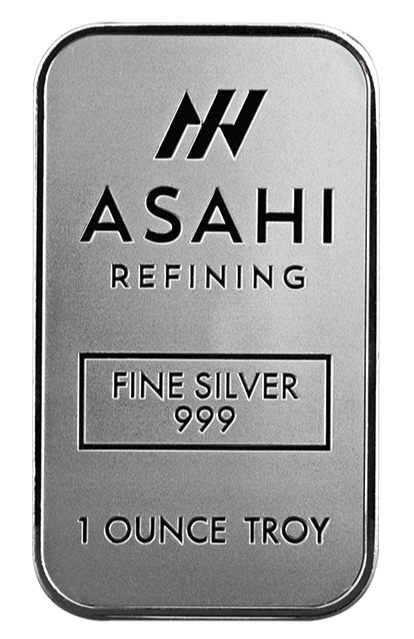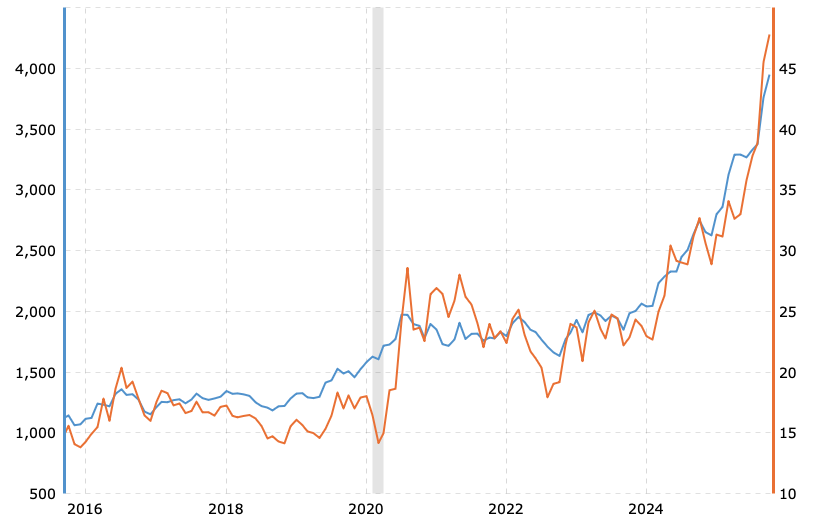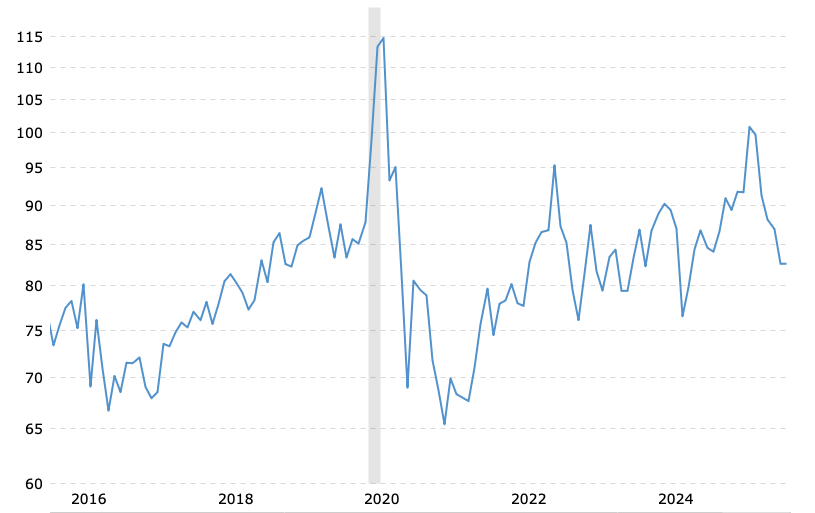Is It Worth Buying Silver Bars?
With inflation still running high, global markets shaky, and the dollar’s strength under constant debate, investors are looking for hard assets that can hold their weight.
That begs the question: Are these cheap, stackable, and globally recognized silver bars actually worth buying?
In this guide, we’ll walk through what silver bars are, why people buy them, when they make the most sense, and how to buy them safely, so you can decide if they’re a smart fit for your portfolio.
Why investors are looking at silver again
In 2025, silver has drawn renewed investor attention as global economic uncertainty drives demand for hard assets.
Unlike stocks or digital investments, silver bars are tangible, finite, and universally recognized. That means while silver is still influenced by factors like market speculation, industrial demand, and interest rate shifts, it tends to hold its ground during inflationary periods, as well as instances of currency instability, and geopolitical tension.
As a result, it serves as both a hedge against inflation and a diversifier in a balanced portfolio.
This stability is what makes silver appealing beyond just numbers on a chart. It offers peace of mind in a way that paper wealth, often vulnerable to policy shifts, banking crises, or digital disruptions, simply can’t.

Moreover, silver stands out for its affordability. Compared to gold, it’s far more accessible, making it easier for younger investors or small savers to start building tangible wealth. Its higher liquidity also makes it simple to buy or sell in smaller quantities without the large capital outlay gold typically requires.
Adding to that, global clean energy trends, particularly the rapid expansion of solar and electric vehicle manufacturing, have significantly boosted industrial demand for silver.
We’ll explore all these factors in more detail later, but it goes without saying that if you’re asking, “Is it really worth buying silver bars in 2025?”, the growing interest among investors speaks for itself.
What exactly are silver bars and how they work
Silver bars are refined slabs of investment-grade silver, typically made from .999 fine silver, meaning they contain 99.9% pure silver. They come in a variety of sizes, from small 1 oz pieces to larger 10 oz, 1 kg, and even 100 oz bars.
Most bars fall into two main categories:
-
Cast bars: These are poured into molds and left with a rougher, matte finish. They have a rugged, industrial look, which often makes them slightly cheaper per ounce due to simpler production methods and lower fabrication costs.
-
Minted bars: These are cut from rolled silver sheets and stamped with clean, precise edges. Their polished and uniform appearance makes them more appealing for collectors or gifting, though they usually come with a higher premium thanks to their refined aesthetics and recognizable branding.
Each bar will usually display markings for weight, purity, and the mint or manufacturer, making them easy to verify, especially when it comes time to resell.
When you buy a silver bar, you're paying a price that includes the spot price of silver (the current market value per ounce) plus a premium, the markup that covers manufacturing, distribution, and dealer margin.
The lower the premium, the more of your money goes directly into the metal itself, not middlemen. Over time, especially in long-term holdings, this can make a noticeable difference in total return if silver prices rise.
The good news is that silver bar premiums are lower than those of silver coins, which means that, with bars, you get more silver for your money. So if you're an investor focused on accumulating ounces at the lowest cost, bars are one of the most efficient ways to do it.
Silver bars are designed for long-term stacking and storage. They’re not meant to be used like currency, but rather to store wealth in a compact, tangible form.
Benefits of buying silver bullion bars
Hedge against inflation and currency devaluation
When inflation rises, every dollar buys less. Groceries go up. Rent climbs. Savings lose value sitting in a bank account.
The same thing happens when a currency weakens, whether from excessive money printing, political instability, or central bank missteps. Your purchasing power erodes, and so does trust in fiat currency.
That’s why investors historically turn to hard assets like silver during these periods.
Silver has maintained its reputation as a store of value for centuries. And over the past 10 years, it’s shown that again and again. Despite volatility, silver prices have surged during inflationary waves and periods of currency pressure.

Source: Mactrotrends Gold Prices vs Silver Prices
For example, between 2020 and 2021, amid global pandemic stimulus and dollar concerns, silver (organge line) jumped over 45% in value. And while it corrected afterwards, it has consistently tracked higher across inflationary cycles from 2015 to 2025, similar to gold’s overall trend (blue line) during the same period.
All that being said, silver consistently performs well when inflation rises or fiat currencies weaken. Its value isn't tied to central bank policy or corporate earnings, making it a practical hedge when other assets lose ground.
Global liquidity
Whether you're in the U.S., Europe, or Asia, most bullion dealers recognize and trade silver bars, especially those from reputable mints like PAMP Suisse, Royal Canadian Mint, or Johnson Matthey.
That's to say if you ever need to liquidate your holdings, chances are you’ll find a buyer without much hassle, regardless of where you are. That flexibility makes silver bars a convenient option for anyone who values access and mobility in their portfolio.
Rising industrial demand
Unlike gold, silver isn’t just a monetary metal. It’s also an essential industrial material. Silver’s unique conductive and reflective properties make it critical for technologies such as
-
Solar panels (photovoltaics)
-
Electric vehicles
-
Semiconductors and 5G networks
-
Medical instruments and antimicrobial coatings
According to the 2025 World Silver Survey, industrial silver demand rose by 4% in 2024 compared to 2023, reaching a record 680.5 million ounces. This growth was driven by the expanding green economy, particularly the photovoltaic (solar) and automotive sectors, as well as grid infrastructure development.
This matters because as global infrastructure and clean energy investments grow, so does silver’s baseline demand – regardless of investor activity. Even if the investment side of silver cools temporarily, industrial demand helps cushion price drops and keeps upward pressure during periods of technological growth.
Easy to store and stack
Silver bars are compact and uniform. Their rectangular shape allows for efficient stacking in safes, vaults, or storage boxes without wasting space.
Unlike coins, which often come with bulky packaging or protective casings, bars are simpler to handle in bulk. That streamlined format reduces the cost and complexity of storage, especially if you're accumulating over time.
Lower premiums than coins
Silver bars generally cost less per ounce than silver coins because they’re simpler and cheaper to produce. Bars don’t require detailed designs, legal tender markings, or individual protective casings, all of which add labor, time, and cost to coins.
As a result, the premium, the amount you pay above the spot price, is much lower for bars. That means more of your money goes into the silver itself, not into fabrication or collectibility.
The downsides of buying silver bars
Higher Entry Size
Silver bars typically require a larger upfront cost than coins, especially as you move into heavier weights like 10 oz, 1 kg, or 100 oz. That’s simply because you’re buying more silver in one go.
Take for instance a 100 oz silver bar at $48/oz, which would cost $4,800 before premiums. This amount can feel out of reach for newer or smaller investors.
That said, while the entry point is higher, remember that the cost per ounce is lower due to lower premiums, and that gives you more silver for the same money. If you're planning to accumulate physical silver holdings, bars are a much more efficient choice over time.
Less flexibility for partial liquidation
In simple terms, this means silver bars are harder to split or sell in smaller amounts.
If you own a 100-oz bar, you can’t just shave off 10 ounces when you want to sell a portion. You’d have to sell the entire bar or find a buyer willing to trade for smaller units, which can take time or involve extra fees.
That’s why bars are less ideal for investors who may need quick access to small amounts of cash. Coins or fractional bars offer more flexibility in that case, while larger bars remain the more cost-effective option for building long-term silver wealth.
Storage and insurance costs for large quantities
Storing a large number of physical silver bars at home can become impractical, both in terms of space and risk. As your holdings grow, so do concerns about theft, fire, or natural disasters, which is why turning to third-party vaulting services or purchase insurance is inevitable.
That’s not to say storage makes silver bars a bad choice. It simply means that beyond a certain point, you’ll need to factor in additional costs and logistics, especially if you’re holding hundreds or thousands of ounces.
Price volatility
Silver prices tend to swing more dramatically than gold primarily because silver is a much smaller market with thinner trading volume. So even modest buying or selling pressure can move the price significantly.
But another layer to this volatility is the fact that silver is both a monetary and industrial metal. This makes its price more sensitive to shifts in manufacturing demand.
When the global economy slows and industrial output drops, silver demand often softens, putting downward pressure on prices. Conversely, when sectors like solar, electronics, or automotive manufacturing ramp up, silver demand and price can spike.
This volatility doesn’t make silver a bad investment. It just means investors should expect more short-term price swings and focus on long-term positioning.
Opportunity cost compared to gold or ETFs
When you buy silver bars, your money sits in a non-yielding asset. It doesn’t earn interest or dividends. That’s the opportunity cost: the potential gains you give up from alternatives like gold, stocks, bonds, or ETFs that can grow faster or provide returns over time.
This becomes a disadvantage if you’re seeking liquidity or quick profits, since silver’s value moves mainly with the market, and storage adds extra cost.
Still, that trade-off is intentional. Silver bars aren’t built for short-term growth. They’re built for stability and protection. In uncertain times, they act as a safe haven hedge, preserving wealth when paper assets falter.
Silver bars vs silver coins: what’s the difference?
We’ve touched on some of the differences between silver bars and coins in earlier sections, but below is a quick rundown:
-
Premiums: Bars usually cost less per ounce since they’re simpler to produce. Coins often carry higher premiums due to minting costs, collectible designs, and legal tender status.
-
Liquidity: Bars work best for bulk selling or long-term stacking. Coins are easier to sell in smaller quantities or resell individually.
-
Design and Appeal: Bars are plain and practical; coins often feature intricate designs or national emblems, making them great for gifting or collecting.
-
Best For: Bars suit long-term investors aiming for maximum silver per dollar, while coins appeal to those who value flexibility or artistry.
If you’d like a deeper comparison, check out our full guide Should I Buy Silver Bars or Coins?
When it makes sense to buy silver bars
When holding long-term as a wealth store
If your goal is to steadily build tangible assets and preserve purchasing power for the long haul, silver bars are a practical, affordable, and efficient way to do it.
They don't rely on credit markets, interest rates, or corporate earnings, which makes them ideal for wealth storage in times of economic uncertainty and geopolitical instability.
When you can store safely or use allocated storage
A 100-oz silver bar is roughly the size of a paperback book. Store ten or twenty of them, and while the value increases, so does the space you’ll need.
But space is only one part of the equation. A large silver holding also brings security risks, both theft and calamities like fire. So if you plan to accumulate significant amounts, it’s best to arrange third-party allocated storage with insurance and professional handling.
You’ll be spending a bit more, but that extra cost is well worth the security and peace of mind.
When silver prices are under historical average vs gold
Silver becomes especially attractive when it’s undervalued relative to gold, something investors often track using the gold-to-silver ratio. This ratio shows how many ounces of silver it takes to buy one ounce of gold.
In the 21st century, the average has hovered between 50:1 and 70:1, according to Investopedia.
When the ratio climbs well above that, say 80:1 or 90:1, it tells us that silver is cheaper compared to gold. In 2020, for example, the ratio briefly hit a record high of around 114:1 before silver rebounded sharply.

Source: Macrotrends Gold to Silver Ratio
Buying silver bars when this ratio is stretched gives investors the chance to buy silver at a relative discount, with the potential to benefit once the ratio reverts to historical norms.
When you’re building a diversified precious metals portfolio
Adding silver bars to a portfolio that already includes gold, platinum, or other safe haven assets gives you broader exposure and reduces your reliance on any single metal’s performance.
Relying solely on one metal, on the other hand, can expose your investment portfolio to unnecessary swings. For example, if gold plateaus or dips, silver might still climb due to industrial demand.
How to buy and invest in silver bars safely
Buy from reputable dealers
Buying from a reputable dealer minimizes your risk of ending up with counterfeit or misrepresented products, an issue that still exists in today’s global bullion market.
But how do you identify a trusted dealer? Look for these:
-
Positive customer reviews and a solid track record
-
Transparent pricing, buyer protection policies, and insured shipping
-
Membership or association with recognized trade groups (e.g. Professional Numismatists Guild)
You should also check that the bars you’re buying have clear verification hallmarks, such as the mint’s logo, weight, and purity stamped directly on the bar.
Well-known mints like PAMP Suisse, Johnson Matthey, and the Royal Canadian Mint include these marks as part of their standard design.
Check purity and weight markings
Purity and weight markings are what buyers and dealers rely on when assessing resale value or authenticity, especially in private transactions where no formal appraisal is done.
Every investment-grade silver bar should display:
-
The weight (e.g., 10 oz, 1 kg, 100 oz)
-
The purity (usually marked as .999 or .9999 fine silver)
-
The manufacturer’s mark or mint logo
On this note, make sure to:
-
Always inspect the bar for clean, legible stamps.
-
Compare the markings to official specs from the mint (check their website or product catalog).
-
If in doubt, have the bar tested by a local bullion dealer or certified assayer.
Understand premiums, taxes, and buyback options
Before buying silver bars, it’s important to understand what you’re actually paying, and what you can realistically get back if you decide to sell.
-
Premiums: This is the amount you pay above the silver spot price. Bars tend to have lower premiums than coins, but they still vary by weight, mint, and dealer. Compare prices from several sources, and look for deals on popular sizes like 10 oz or 100 oz bars to get the best value.
-
Taxes: In the U.S., most states either exempt bullion from sales tax or have specific rules based on minimum purchase amounts. Always check your local tax laws before buying. Better yet, get professional tax advice.
-
Buyback options: Not every dealer offers a buyback program, and some pay significantly less than spot. Before you buy, ask:
-
Do you offer buyback?
-
How is the price determined?
-
Are there minimums or hidden fees?
Think about storage considerations wisely
When investing in silver bars, you should ideally already have a storage plan in mind. For smaller amounts, a fire-rated, bolted-down home safe gives you direct control and easy access.
For larger holdings, consider other silver storage options. In this case, it’s highly recommended to use an insured vault or allocated storage service. These facilities offer professional handling, theft protection, and climate control.
Either way, keep detailed records, take photos, and ensure that your insurance coverage reflects the declared value. Safe storage is a non-negotiable part of buying silver bars responsibly.
Plan your exit or resale strategy upfront
You shouldn't wait until you need cash to figure out how to sell your silver bars. Having a resale strategy in place helps you avoid panic selling, lowball offers, or delays when liquidity matters most.
Before you buy:
-
Choose dealers that offer clear buyback policies.
-
Favor bars from well-known mints to make resale easier.
-
Track your original purchase details (weight, price, dealer, and invoice)
If you're storing at home, make sure your silver is organized and easy to inventory. If you're using third-party storage, understand how the withdrawal and sale process works.
This way, whether prices spike or you need quick liquidity, you're not scrambling. You're ready.
Ready to Invest in Silver Bars? Check Out Aurica's Silver Collection. https://auricainternational.com/store]
Final thoughts – Is it worth it in 2025?
If you're thinking long-term, buying from trusted dealers, and building a diversified portfolio, then yes, silver bars are worth it in 2025.
They’re affordable compared to gold, easy to store, globally liquid, and offer strong upside during inflation, currency devaluation, or industrial expansion.
Finally, make them just one part of a broader strategy, alongside other precious metals, cash reserves, and income-generating assets. That’s how you get both stability and growth potential without overexposing yourself to a single asset class.
Explore certified silver bars from Aurica and start investing confidently today. https://auricainternational.com/store]
FAQs
Are silver bars harder to sell than coins?
Not necessarily, but they can be harder to sell in small amounts. Bars are better suited for bulk transactions, while coins are easier to sell off gradually or in smaller pieces.
What is the smallest silver bar size worth buying?
The 1 oz silver bar is the smallest size most buyers consider worthwhile. Smaller bars exist, but they often come with disproportionately high premiums relative to their size.
Are silver bars taxed in Canada or the U.S.?
In the U.S., many states exempt bullion from sales tax, but others don’t. In Canada, silver bars that meet purity requirements are generally GST/HST-exempt. That said, always check local rules before buying or seek professional tax advice.
Is buying silver a good idea right now?
Yes, if you're buying from trusted sources and holding long-term. Silver remains undervalued relative to gold and benefits from rising industrial demand.
Do silver bars hold their value?
Yes, especially over the long term. While short-term prices fluctuate, silver has historically preserved wealth during inflation and market instability.
What size silver bar is best for investment?
The best size of silver bar to buy are 10 oz and 100 oz bars. Both strike the best balance between low premiums and manageable storage. They’re also cost-efficient for long-term stacking and still relatively liquid when selling.

